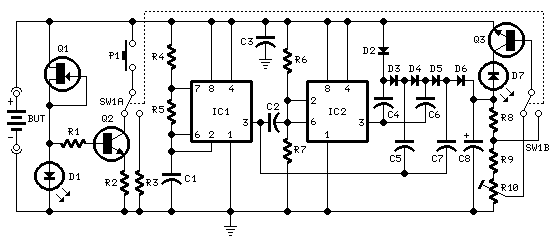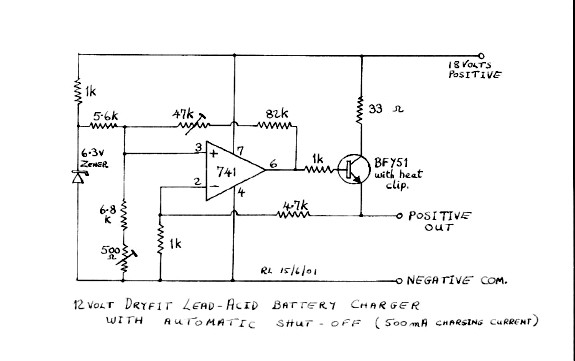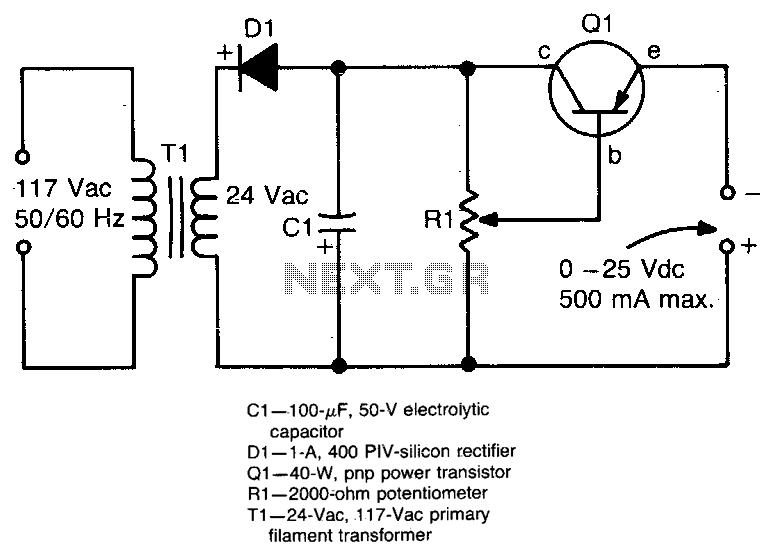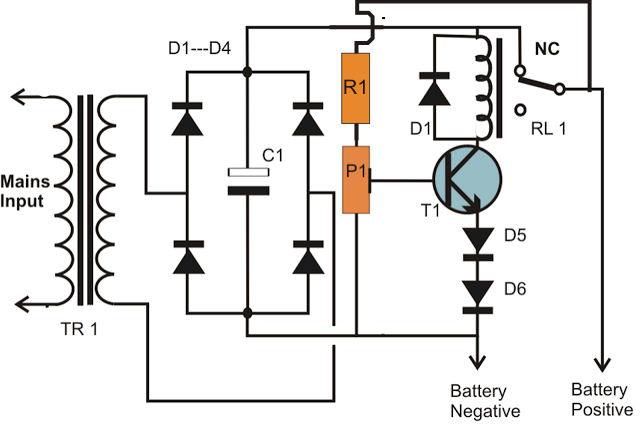
UNIVERSAL BATTERY CHARGER
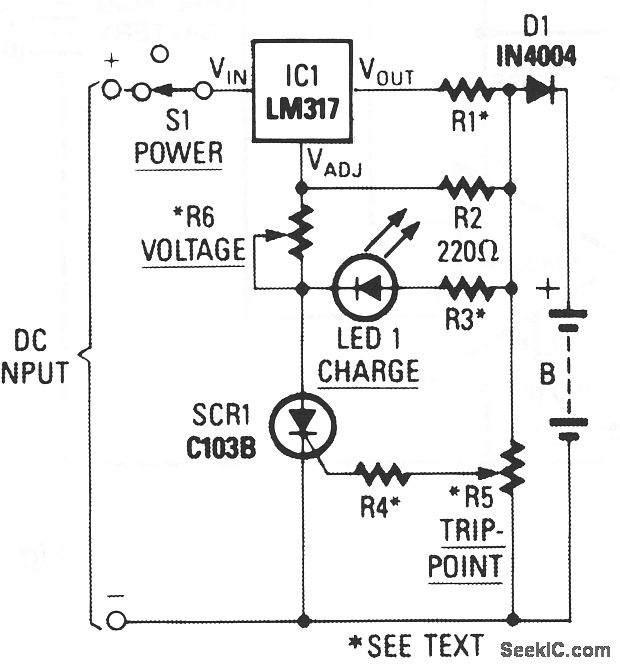
When power is applied to the circuit, SCR1 remains off, resulting in no bias-current path to ground; consequently, the LM317 operates as a current regulator. The LM317 is connected to the battery through steering diode D1, limiting resistor R1, and bias resistor R2. The steering diode prevents the battery from discharging through the LED and the SCR when power is removed from the circuit. As the battery charges, the voltage across trip-point potentiometer R5 increases and eventually activates the SCR. At this point, current from the regulator can flow to ground, allowing the regulator to switch to voltage mode. When the SCR is activated, it also provides LED1 with a path to ground through R3. Therefore, when LED1 is illuminated, the circuit is in voltage-regulating mode; conversely, when LED1 is off, the circuit operates in current-regulating mode.
The described circuit utilizes a silicon-controlled rectifier (SCR) and an LM317 voltage regulator to manage the charging of a battery while maintaining a switchable operation mode between current regulation and voltage regulation. Initially, when power is supplied, the SCR (SCR1) is non-conductive, and the LM317 functions strictly as a current regulator. The connection of the LM317 to the battery is established through a steering diode (D1), which ensures unidirectional current flow, thus preventing reverse discharge from the battery into the circuit components when power is not present.
The limiting resistor (R1) and bias resistor (R2) are critical for setting the appropriate operating conditions for the LM317. The voltage across the battery is monitored by the trip-point potentiometer (R5), which plays a pivotal role in determining when the SCR will be triggered. As the battery charges, the voltage across R5 increases until it reaches a threshold that activates the SCR, allowing current to flow to ground and transitioning the regulator's operation from current mode to voltage mode.
Once the SCR is triggered, it creates a conductive path for LED1 through resistor R3, illuminating the LED. This visual indication signifies that the circuit has switched to voltage-regulating mode. The operation of the circuit can thus be summarized: the presence of power and the state of LED1 inform users of the current operational mode—current regulation when LED1 is off and voltage regulation when LED1 is on. This design effectively combines battery management with user feedback through LED indication, ensuring efficient charging and operation of the connected load.When power is applied to the circuit, SCR1 is off, so there is no bias-current path to ground; thus, LM317 acts as a current regulator. The LM317 is connected to the battery through steering diode D1, limiting resistor R1, and bias resistor R2.
The steering diode prevents the battery from discharging through the LED and the SCR when power is remov ed from the circuit. As the battery charges, the voltage across trip-point potentiometer R5 rises, and at some point, turns on the SCR. Then, current from the regulator can flow to ground, so the regulator now functions in the voltage mode.
When the SCR turns on, it also provides LED1 with a path to ground through R3. So, when LED1 is on, the circuit is in the voltage-regulating mode; when LED1 is off, the circuit is in the current-regulating mode. 🔗 External reference
The described circuit utilizes a silicon-controlled rectifier (SCR) and an LM317 voltage regulator to manage the charging of a battery while maintaining a switchable operation mode between current regulation and voltage regulation. Initially, when power is supplied, the SCR (SCR1) is non-conductive, and the LM317 functions strictly as a current regulator. The connection of the LM317 to the battery is established through a steering diode (D1), which ensures unidirectional current flow, thus preventing reverse discharge from the battery into the circuit components when power is not present.
The limiting resistor (R1) and bias resistor (R2) are critical for setting the appropriate operating conditions for the LM317. The voltage across the battery is monitored by the trip-point potentiometer (R5), which plays a pivotal role in determining when the SCR will be triggered. As the battery charges, the voltage across R5 increases until it reaches a threshold that activates the SCR, allowing current to flow to ground and transitioning the regulator's operation from current mode to voltage mode.
Once the SCR is triggered, it creates a conductive path for LED1 through resistor R3, illuminating the LED. This visual indication signifies that the circuit has switched to voltage-regulating mode. The operation of the circuit can thus be summarized: the presence of power and the state of LED1 inform users of the current operational mode—current regulation when LED1 is off and voltage regulation when LED1 is on. This design effectively combines battery management with user feedback through LED indication, ensuring efficient charging and operation of the connected load.When power is applied to the circuit, SCR1 is off, so there is no bias-current path to ground; thus, LM317 acts as a current regulator. The LM317 is connected to the battery through steering diode D1, limiting resistor R1, and bias resistor R2.
The steering diode prevents the battery from discharging through the LED and the SCR when power is remov ed from the circuit. As the battery charges, the voltage across trip-point potentiometer R5 rises, and at some point, turns on the SCR. Then, current from the regulator can flow to ground, so the regulator now functions in the voltage mode.
When the SCR turns on, it also provides LED1 with a path to ground through R3. So, when LED1 is on, the circuit is in the voltage-regulating mode; when LED1 is off, the circuit is in the current-regulating mode. 🔗 External reference


